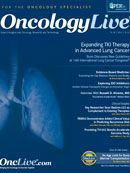Publication
Article
Oncology Live®
Afatinib Tablets Now Available for Use in Treatment of NSCLC
Author(s):
Afatinib (Gilotrif) tablets were approved by the FDA on July 15, 2013, as a first-line oral treatment for non– small cell lung cancer with EGFR mutations. The oral tablets became commercially available in the United States September 2.
Afatinib (Gilotrif) tablets were approved by the FDA on July 15, 2013, as a first-line oral treatment for non— small cell lung cancer (NSCLC) with epidermal growth factor receptor (EGFR) mutations.1 The oral tablets became commercially available in the United States September 2.
Using an FDA-approved test kit, clinicians can make an informed decision on whether to initiate afatinib based on EGFR mutations in cancer cells. The FDA approved afatinib concurrently with the therascreen EGFR RGQ PCR Kit, a companion diagnostic that helps determine if a patient’s lung cancer cells express the EGFR mutations. Although the effectiveness of afatinib has been validated in patients with NSCLC with exon 19 deletions and exon 21 (L858R) substitution mutations, efficacy and safety have not been proven with other types of EGFR mutations.2
Pharmacology and Pharmacokinetics
Afatinib, a tyrosine kinase inhibitor, reduces ErbB signaling by binding to the kinase domains of EGFR, HER2, and HER4. ErbB receptors are involved in the growth and proliferation of cancer cells.2
Maximum concentrations of afatinib occur 2 to 5 hours after administration. With an elimination half-life of 37 hours, steady-state plasma levels are reached within 8 days. In pharmacokinetic studies, high-fat meals and p-glycoprotein (p-gp) inhibitors increased peak concentrations of afatinib and total exposure to it. Afatinib is minimally metabolized by liver enzymes, with 88% of each dose recovered unchanged, primarily in feces.2
Patients with mild-to-moderate renal impairment experienced higher trough concentrations of afatinib than patients with normal renal function. Hepatic impairment did not affect exposure. No dose adjustment is required in hepatic or renal impairment, but patients with severe renal impairment (creatinine clearance <30 mL/min) and patients with Child-Pugh class C hepatic dysfunction have not received afatinib in clinical studies.2
Dosage and Administration
A single, daily, oral dose of afatinib should be taken on an empty stomach ≥1 hour before or ≥2 hours after a meal, preferably at the same time each day. If a patient misses the usual administration time, the missed dose may be taken at a later time, but only if the patient separates daily doses by at least 12 hours. The usual daily dose of afatinib is 40 mg, although dose reductions may be necessary when restarting therapy after adverse events or to manage drug interactions.2
Clinical Trials
Patients with metastatic, nonsquamous NSCLC, enrolled in the phase III LUX-Lung 3 trial, received afatinib (230 patients) or a combination of pemetrexed and cisplatin (115 patients). Patients taking afatinib experienced a median progression-free survival of 11.1 months versus 6.9 months for patients taking pemetrexed/cisplatin (P = .001). The difference in survival was more pronounced in patients with tumors harboring exon 19 deletions and L858R EGFR mutations. Patients with those specific mutations who received afatinib experienced a median progression-free survival of 13.6 months compared with 6.9 months in the chemotherapy arm.3
Diarrhea occurred in 96% of patients treated with afatinib, of which 15% was grade 3. For patients who develop prolonged grade 2 diarrhea lasting ≥48 hours, or equal to grade 3, afatinib should be withheld until diarrhea resolves to ≤ grade 1 and resumed with appropriate dose reduction.2
Warnings and Precautions
In addition to diarrhea, the most common grade 3 drug-related adverse events observed in the afatinib treatment arm were rash (16%) and inflammation of the nail bed (paronychia) (11%). The most common drug-related grade 3 adverse events observed in the pemetrexed/cisplatin arm were neutropenia (15%), fatigue (13%), and leucopenia (8%). There was a low discontinuation rate associated with treatment-related adverse events in the trial (8% discontinuation rate for afatinib; 12% for chemotherapy).1 P-gp inhibitors such as ritonavir, cyclosporine, ketoconazole, itraconazole, erythromycin, verapamil, tacrolimus, and amiodarone may increase exposure to afatinib. Likewise, p-gp inducers such as rifampin, carbamazepine, phenytoin, phenobarbital, and St. John’s wort may reduce exposure to afatinib. Concomitant use of a p-gp inhibitor requires a 10-mg afatinib dose reduction. If the p-gp inhibitor is discontinued, the usual dose of afatinib may be restored after 2 to 3 days without the p-gp inhibitor.2 Afatinib is a pregnancy category D medication. Animal studies show an increased risk of fetal death, reduced fetal weight, and skeletal, vascular, and dermal abnormalities. 2
Resources
Afatinib is manufactured by Ridgefield, Connecticut—based Boehringer Ingelheim Pharmaceuticals, Inc. The company has established a patient support program for clinical and financial support services, including Solutions PlusTM, a program to facilitate patients’ access to the drug. For more information, call 1-877-814-3915 or visit www.bisolutionsplus.com.
References
- Boehringer Ingelheim [press release]. US FDA approves Afatinib (afatinib) as first-line treatment for lung cancer patients with EGFR mutations. www.boehringer-ingelheim.com/news/news_releases/press_ releases/2013/15_july_2013_oncology.html. Accessed August 2013.
- Afatinib (afatinib) [package insert]. Ridgefield, CT: Boehringer Ingelheim Pharmaceuticals, Inc; 2013
- Sequist LV, Yang J C-H, Yamamoto N, et al. Phase III study of afatinib or cisplatin plus pemetrexed in patients with metastatic lung adenocarcinoma with EGFR mutations [published online ahead of print July 1, 2013]. J Clin Oncol. doi: 10.1200/JCO.2012.44.2806.



























%20(2)%201-Recovered-Recovered-Recovered-Recovered-Recovered-Recovered-Recovered-Recovered-Recovered-Recovered-Recovered-Recovered-Recovered-Recovered-Recovered-Recovered-Recovered.jpg?fit=crop&auto=format)
%20(2)%201-Recovered-Recovered-Recovered-Recovered-Recovered-Recovered-Recovered-Recovered-Recovered-Recovered-Recovered-Recovered-Recovered-Recovered-Recovered-Recovered-Recovered.jpg?fit=crop&auto=format)
